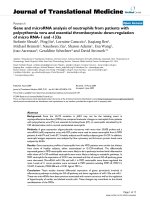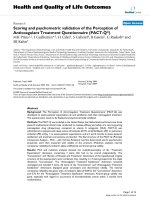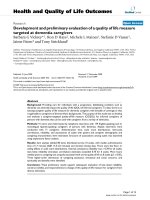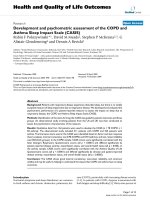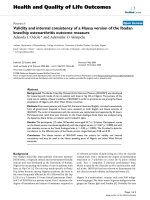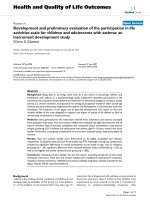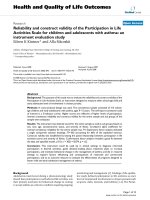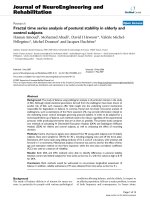Báo cáo hóa học: " Structure and Photoluminescent Properties of ZnO Encapsulated in Mesoporous Silica SBA-15 Fabricated by Two-Solvent Strategy" doc
Bạn đang xem bản rút gọn của tài liệu. Xem và tải ngay bản đầy đủ của tài liệu tại đây (454.74 KB, 9 trang )
NANO EXPRESS
Structure and Photoluminescent Properties of ZnO Encapsulated
in Mesoporous Silica SBA-15 Fabricated by Two-Solvent Strategy
Qingshan Lu Æ Zhongying Wang Æ Jiangong Li Æ
Peiyu Wang Æ Xialei Ye
Received: 8 January 2009 / Accepted: 5 March 2009 / Published online: 21 March 2009
Ó to the authors 2009
Abstract The two-solvent method was employed to pre-
pare ZnO encapsulated in mesoporous silica (ZnO/SBA-15).
The prepared ZnO/SBA-15 samples have been studied by
X-ray diffraction, transmission electron microscope, X-ray
photoelectron spectroscopy, nitrogen adsorption–desorption
isotherm, and photoluminescence spectroscopy. The ZnO/
SBA-15 nanocomposite has the ordered hexagonal meso-
structure of SBA-15. ZnO clusters of a high loading are
distributed in the channels of SBA-15. Photoluminescence
spectra show the UV emission band around 368 nm, the
violet emission around 420 nm, and the blue emission
around 457 nm. The UV emission is attributed to band-edge
emission of ZnO. The violet emission results from the oxy-
gen vacancies on the ZnO–SiO
2
interface traps. The blue
emission is from the oxygen vacancies or interstitial zinc
ions of ZnO. The UV emission and blue emission show a
blue-shift phenomenon due to quantum-confinement-
induced energy gap enhancement of ZnO clusters. The ZnO
clusters encapsulated in SBA-15 can be used as light-emit-
ting diodes and ultraviolet nanolasers.
Keywords ZnO Á Clusters Á Mesoporous silica Á
Photoluminescence
Introduction
Semiconductors usually exhibit quantum size effects and
electric and optical properties different from bulk materi-
als, when their particle size decreases to nanometer scale
[1]. The fabrication strategy for semiconductor nanostruc-
ture includes a wide variety of vapor, liquid, and solid state
processing routes [2]. Different techniques such as pulsed
laser deposition, sputtering, thermal evaporation and con-
densation, solid state reaction, and chemical method have
been employed to fabricate such nanostructures. Among
these techniques, the template-assisted synthesis, which
involves confined growth of nanostructures because of
volume space effect, provides a simple, low-cost, and high-
yield synthetic route for a large variety of materials.
Among various hard templates such as track-etched poly-
carbonate, polystyrene sphere (PS) colloidal monolayer
template, single-walled carbon nanotube, and anodized
aluminum oxide (AAO), ordered mesoporous silica SBA-
15 [3] is one prominent example and was used to construct
nanostructures because of its uniform pore size, hexagonal
array of one-dimensional cylindrical channels, large sur-
face areas, and high thermal stability. Therefore, it is
convenient to stabilize highly dispersed ultrafine metal or
oxide nanocrystals, nanowires, quantum dots, and clusters
in the channels of SBA-15.
ZnO is a multifunctional semiconductor material. Due to
the features such as a wide band gap of 3.37 eV, a high
exciton binding energy of 60 meV at room temperature, and
special electrical and optoelectronic properties [4], a wide
range of potential applications [5] from fine photoelec-
tronics, transparent conductive films, solar cell windows,
and acoustic wave devices to gas sensing devices excite
intensive studies on ZnO nanostructures. In addition to
conventional nanoparticles, the various ZnO nanostructures
Q. Lu Á Z. Wang Á J. Li (&) Á P. Wang Á X. Ye
Institute of Materials Science and Engineering,
Lanzhou University, Lanzhou 730000, China
e-mail:
123
Nanoscale Res Lett (2009) 4:646–654
DOI 10.1007/s11671-009-9294-x
including quantum dots [6], nanowires [7], nanorods [8],
and nanocastles [9] have been found to show unique optical,
optoelectronic, and photocatalytic properties. The com-
posite of carbon nanoparticles embedded in ZnO matrix was
studied as a solar thermal absorber in solar energy appli-
cations [10]. Furthermore, ZnO is a promising material for
potential optical applications [11] and has potential appli-
cation as a short-wave-length light emitting material. Now,
a lot of studies are concentrated on tuning the band gap of
ZnO by changing the diameter of particle size because of
strong size-dependent band gap. All these have excited
researches to develop new synthetic methodologies to pre-
pare well-controlled ZnO nanostructures.
Up-to-date, several strategies have been developed to
incorporate ZnO in the channels of mesoporous silica SBA-
15 and MCM-41 and the pores of zeolites. Two examples
are conventional wetness impregnation [12–15] and the
improved method with modification of the surface walls
followed by loading precursor through affinity interaction
[16, 17]. Generally, the former method seems difficult to
completely avoid adsorptions of the ZnO precursor on the
outer surface of the host template. The uncontrolled ZnO
aggregation on the external surface of mesoporous silica
will form in subsequent calcinations. The latter method
involves complicated process and has low yield. So, it is
necessary to develop a simple and low cost novel strategy
to prepare ZnO encapsulated in SBA-15 with high quantum
size effect and thermal stability.
Recently, a novel strategy called two-solvent method
containing hydrophilic and hydrophobic solvents has been
applied to prepare CoFe
2
O
4
nanowires in carbon nanotubes
[18, 19]. This method is based on a volume of precursor
aqueous solution equal to the pore volume of host template
materials which has the advantages of confining and dis-
tributing guest species within the pores of host template.
Therefore, mesoporous silica SBA-15 could be regarded as
a nanoreactor for constructing guest nanomaterials with
controlled size and size distribution. The two-solvent
method may be employed to prepare a nanocomposite of
ZnO clusters supported in mesoporous silica. However, the
synthesis of zinc oxide encapsulated in mesoporous silica
SBA-15 by the two-solvent method has not been studied so
far.
In our present work, we prepared a nanocomposite of
ZnO clusters supported in mesoporous silica (or ZnO/SBA-
15) via the two-solvent synthetic route. The structure and
photoluminescent properties of the ZnO/SBA-15 nano-
composite were studied. The results show that ZnO clusters
are distributed in the channels of SBA-15 without aggre-
gations found on the external surface of SBA-15. The UV
and blue emissions show a significant blue shift due to
quantum size effect compared to the emission of the bulk
counterpart reported in the literatures.
Experimental Section
Preparation
The ZnO/SBA-15 nanocomposite was prepared by incor-
porating zinc nitrate precursor into the channels of
mesoporous silica SBA-15 and subsequent calcination.
Parent mesoporous silica SBA-15 was synthesized
according to the reported process [20]. A typical synthetic
procedure was carried out as follows: 4 g of triblock
copolymer P123 [HO(CH
2
CH
2
O)
20
(CH
2
CH(CH
3
)O)
70
(CH
2
CH
2
O)
20
H, abbreviated as EO
20
PO
70
EO
20
], was
mixed with 120 mL of 2 M hydrochloric acid (HCl) and
30 mL of deionized water. The mixture was stirred at
38 °C until P123 was completely dissolved. A total of
8.5 g of tetraethyl orthosilicate (TEOS) was added to this
solution under vigorous stirring. The final mixture was
stirred at 38 °C for 24 h, then transferred into a teflon-lined
autoclave, and kept in the autoclave at 100 °C for 24 h
under static condition for hydrothermal treatment. Finally,
the formed white precipitates were filtered, washed with
water, and dried at room temperature. The extracted mes-
oporous silica SBA-15 was obtained by removing P123
with ethanol extraction method under refluxing condition.
The procedure of incorporating ZnO into the channels of
SBA-15 is as follows [21]. A total of 1 g of extracted
mesoporous silica SBA-15 was suspended in 20 mL of
n-hexane as the first hydrophobic solvent; and the mixture
was stirred for 2 h. A total of 0.98 mL of zinc nitrate
solution of different concentrations as the second hydro-
philic solvent was added to the above mixture dropwise.
The resulting solution was vigorously stirred until a paste-
like product was obtained. The paste-like product was dried
for 12 h in air at room temperature. Finally, ZnO/SBA-15
nanocomposite was obtained by calcining the dried (paste-
like) product at 500 °C for 4 h at a heating rate of 1 °C/min
in air. The ZnO/SBA-15 nanocomposites with different
ZnO loadings are referred as x wt% ZnO/SBA-15, where
x represents the weight percentage of ZnO in the
nanocomposite.
Characterizations
Low-angle and wide-angle X-ray diffraction (XRD) mea-
surements were carried out on a Rigaku D/Max-2400 X-ray
diffractometer using CuK
a
radiation in h - 2h scan mode.
High resolution transmission electron microscope (HRTEM)
observations and energy dispersive spectroscopy (EDS)
measurements were conducted on a JEOL JEM 2010 elec-
tron microscope operated at 200 kV. X-ray photoelectron
spectroscopy (XPS) measurements were carried out on a
PHI-5702 spectrometer (Physical Electronics, Inc.) using an
AlK
a
X-ray source (1486.7 eV). The energy scale was
Nanoscale Res Lett (2009) 4:646–654 647
123
internally calibrated by referencing to the binding energy of
the C 1s peak of a carbon contaminant at 284.6 eV. Nitrogen
adsorption–desorption isotherms were measured by a
Micromeritics ASAP2010 system. Barrett–Emmett–Tellter
(BET) method in the relative pressure P/P
0
range of
0.01–0.20 was applied for calculating specific surface areas.
The pore volume was determined from the adsorption branch
of the N
2
isotherm curve at the P/P
0
= 0.97 signal point. The
pore diameter was derived from the maximum of the pore
size distribution curve obtained using Barrett–Joyner–
Halenda (BJH) method based on the adsorption branch of the
N
2
isotherm curve. Room temperature photoluminescence
(PL) spectra were recorded on a FLS-920T fluorescence
spectrophotometer with Xe 900 (450 W xenon arc lamp) as
the light source using an excitation wavelength of 325 nm.
Results and Discussion
The schematic drawing for the structure formation mech-
anism of the ZnO/SBA-15 nanocomposite is shown in
Fig. 1. This synthetic approach is based on the absorption
of hydrophilic zinc nitrate solution into hydrophilic chan-
nels of SBA-15 by capillary forces due to the interaction
between the polar solvent and the hydrophilic part of the
channels. ZnO forms inside the channels of SBA-15 during
calcination.
Figure 2 shows the low-angle XRD patterns of the
extracted mesoporous silica SBA-15 and the ZnO/SBA-15
nanocomposite. The low-angle XRD pattern of the extrac-
ted SBA-15 exhibits three well-resolved diffraction peaks at
2h = 0.84°, 1.45° , and 1.68°, and the corresponding d
spacings are 10.5, 6.0, and 5.3 nm, respectively. The d
spacing ratios of three peaks are exactly 1:1/
ffiffiffi
3
p
:1/2; these
three diffraction peaks can be indexed as (100), (110), and
(200) diffractions associated with highly ordered meso-
porous silica SBA-15 with a two-dimensional hexagonal
symmetry (space group p6mm) [20]. In comparison to the
extracted SBA-15, the ZnO/SBA-15 nanocomposites show
low angle XRD patterns similar to that of SBA-15. Obvi-
ously, the hexagonal ordered structures are retained well
even after the mixing and calcination process, indicating
that the introduction of ZnO into SBA-15 does not collapse
the mesoscopic order of a two-dimensional hexagonal
structure. It is confirmed that SBA-15 has a thermal stability
when used as hard template. The main diffraction peaks of
the extracted SBA-15, 8 wt% ZnO/SBA-15, 15 wt% ZnO/
SBA-15, and 20 wt% ZnO/SBA-15 with 2h = 0.84°, 0.89°,
0.88° and 0.86° are shown in Fig. 2, respectively. It is
obvious that all low-angle XRD peaks of the ZnO/SBA-15
nanocomposite shift to high angles, when compared to the
extracted SBA-15. This is due to the contraction of the silica
frameworks during calcination. In addition, the d
100
inter-
planar spacings of 8 wt% ZnO/SBA-15, 15 wt% ZnO/SBA-
15, and 20 wt% ZnO/SBA-15 are 9.9, 10.0, and 10.3 nm,
respectively. A clear increase of the d
100
interplanar spacing
has been observed with increasing ZnO loading. This sug-
gests that the mesoporous structure of the ZnO/SBA-15
nanocomposite expands with increasing ZnO loading [16,
22]. Based on a
0
= 2d
100
/
ffiffiffi
3
p
[20], where a
0
represents the
pore-to-pore distance of the hexagonal structure, the unit
cell parameter a
0
of the ZnO/SBA-15 nanocomposite is
calculated to be 11.4, 11.6, and 11.9 nm for the ZnO
loadings of 8 wt%, 15 wt%, and 20 wt%, respectively.
Figure 3 shows wide-angle XRD patterns of the ZnO/
SBA-15 nanocomposites with different ZnO loadings. All
the ZnO/SBA-15 nanocomposites exhibit the broad diffuse
peaks attributed to the non-crystalline silica and ZnO. No
diffraction peaks of the ZnO crystalline phase were
detected in the wide-angle XRD patterns, even for the high
weight percentage of 20 wt% ZnO, indicating that ZnO in
the ZnO/SBA-15 nanocomposites is non-crystalline or may
exist as clusters with ultrafine particle sizes. This result is
same as that reported for other metal oxides clusters inside
the channels of SBA-15 [12, 23].
Fig. 1 Schematic drawing for the structure formation mechanism of
ZnO/SBA-15 nanocomposite
Fig. 2 Low-angle XRD patterns of the extracted SBA-15 (curve A),
the 8 wt% ZnO/SBA-15 nanocomposite (curve B), the 15 wt% ZnO/
SBA-15 nanocomposite (curve C), and the 20 wt% ZnO/SBA-15
nanocomposite (curve D)
648 Nanoscale Res Lett (2009) 4:646–654
123
In order to obtain more information about the existence
and form of ZnO in the ZnO/SBA-15 nanocomposites, the
20 wt% ZnO/SBA-15 nanocomposite was calcined at dif-
ferent temperatures and analyzed by XRD. As shown in
Fig. 4, the 20 wt% ZnO/SBA-15 nanocomposite calcined
at 500 °C yields only a broad diffuse peak which should be
attributed to non-crystalline silica and ZnO. The 20 wt%
ZnO/SBA-15 nanocomposite calcined at 650 °C yields the
seven diffraction peaks overlapped on the diffuse peak of
the non-crystalline silica. The seven diffraction peaks at
2h = 31.74°, 34.36°, 36.28°, 47.64°, 56.58°, 62.90°, and
67.90° can be indexed as (100), (002), (101), (102), (110),
(103), and (112) diffractions of the ZnO wurtzite [6],
respectively. Therefore, ZnO in the 20 wt% ZnO/SBA-15
nanocomposite calcined at 650 °C exists in form of
the crystalline ZnO wurtzite phase. ZnO in the 20 wt%
ZnO/SBA-15 nanocomposite calcined at 500 °C exists in
form of the non-crystalline ZnO phase or ZnO clusters.
Vepr
ˇ
ek [24] reported that nanocrystalline Si with the
average crystallite size less than 3.5 nm can reduce its
excess energy stored in the high density grain boundaries,
if it transforms structurally from a nanocrystalline into a
non-crystalline structure. That is to say, Si can exist stably
in the form of non-crystalline phase when the clusters are
smaller than 3.5 nm and in the form of crystalline phase
when the crystallites are larger than 3.5 nm. In our study,
the precursor aqueous solution is homogeneous distributed
on the large inner surface areas of SBA-15. In subsequent
calcination at 500 °C, the Zn(NO
3
)
2
decomposes and the
ultrafine ZnO clusters may form. When the formed ZnO
clusters are too fine, the ZnO clusters may exist stably in
the form of non-crystalline phase. With the annealing
temperature increasing to 650 °C, the average size of the
ZnO clusters will increase to reach the critical size of the
crystalline phase. Then ZnO exists stably in the form of the
crystalline structure with a low energy state. Li et al. [25]
reported the thermal decomposition of Zn(NO
3
)
2
to ZnO at
the calcination temperature of 150 °C. The ZnO clusters
formed in the channels of SBA-15 are so fine that they exist
in amorphous state [16]. The ZnO clusters can exist stably
at a higher temperature (500 °C) (Fig. 4), which enlarges
the scope of applications.
The mesoporous structures of the ZnO/SBA-15 nano-
composite were studied by the TEM observations. Figure 5
shows the TEM micrographs of the 15 wt% ZnO/SBA-15
nanocomposite. The low magnification TEM micrograph in
Fig. 5a shows the overall morphology of the ZnO/SBA-15
nanocomposite. The parallel straight channels (Fig. 5b) can
be observed with the incident electron beam perpendicular
to the channels. When observed with the incident beam
parallel to the channels, as shown in Fig. 5c, the 15 wt%
ZnO/SBA-15 nanocomposite shows the highly ordered
honeycomb-like pore array structure. The diameter of the
uniform pores is about 5.9 nm. The ZnO/SBA-15 nano-
composite has a two-dimensional hexagonal mesoporous
structure same as SBA-15. The unit cell parameter a
0
(the
distance between two neighboring pore centers) is about
11.6 nm, which is in good agreement with 11.6 nm deter-
mined by the XRD analysis. The ZnO clusters could not be
observed in the channels through TEM investigations
(Fig. 5b). This may be due to the fact that the image
contrast between the silica framework and ZnO clusters is
weak, as in the case of ZnO clusters encapsulated inside the
micropores of zeolite [14].
The EDS analysis was carried out on the 15 wt% ZnO/
SBA-15 nanocomposite with the EDS attachment on the
TEM. Figure 6 illustrates the EDS pattern of the 15 wt%
ZnO/SBA-15 nanocomposite. The C and Cu elements
come from the supporting carbon film and the copper grid,
Fig. 3 Wide-angle XRD patterns of the ZnO/SBA-15 nanocompos-
ites with ZnO loadings of 8 wt% (curve A), 15 wt% (curve B), and
20 wt% (curve C)
Fig. 4 Wide-angle XRD patterns of the 20 wt% ZnO/SBA-15
nanocomposite calcined at different temperatures
Nanoscale Res Lett (2009) 4:646–654 649
123
respectively. The strong zinc signals can be clearly detec-
ted, confirming the presence of Zn element in ZnO/SBA-15
nanocomposite.
To obtain the additional evidence for confirming the
presence of ZnO in the ZnO/SBA-15 nanocomposite, the
XPS was employed to determine the chemical state of the
zinc element in the ZnO/SBA-15 nanocomposite. Figure 7
depicts the typical XPS spectra of the ZnO/SBA-15
nanocomposite. The peaks around 102.9 eV, 532.2 eV and
1021.9 eV were detected. The peak at a binding energy of
102.9 eV is from Si 2p which can be assigned to silica in
SBA-15 [26]. The O 1s peak centered at about 532.2 eV is
asymmetric, indicating the presence of more than one
chemical environment for oxygen species. The O 1s peak
can be fitted with two Gaussian peaks. The weaker shoul-
der peak at about 530.1 eV can be attributed to the oxygen
in pure ZnO [27]. The main peak at about 532.2 eV can be
assigned to the oxygen in the non-crystalline silica of SBA-
15. In our work, most of oxygens detected by XPS are from
non-crystalline silica walls of SBA-15. It is well-known
that the valence electron density of O in the Si–O–Si bond
is lower than that in the Zn–O–Zn bond, due to the higher
electronegativity of Si (1.9) than that of Zn (1.65) [28]. A
peak at 1021.9 eV (Fig. 7c) is ascribed to the core level of
Zn 2p
3/2
of ZnO [29]. The XPS results confirm that ZnO
exists in the ZnO/SBA-15 nanocomposite.
Fig. 5 Low magnification TEM
micrograph of the 15 wt% ZnO/
SBA-15 nanocomposite (a) and
high magnification TEM
micrographs observed with the
electron beam perpendicular to
the channels (b) and parallel to
the channels (c)
Fig. 6 EDS pattern of the 15 wt% ZnO/SBA-15 nanocomposite
650 Nanoscale Res Lett (2009) 4:646–654
123
Figure 8 shows the nitrogen adsorption–desorption iso-
therms of the extracted SBA-15 and the ZnO/SBA-15
nanocomposites with different ZnO loadings. All the
samples show the type IV isotherms with H1-type hyster-
esis loops defined by IUPAC, typical for mesoporous
materials with two-dimensional hexagonal structures [30].
There is no change in the isotherm type observed, proving
that well ordered mesoporous cylinder channels are well
conserved during the formation of ZnO clusters inside
SBA-15, which is coincident with the results obtained from
the low-angle XRD and TEM analysis. Physicochemical
parameters of the samples are summarized in Table 1. The
BET surface area, pore diameter, and pore volume of the
ZnO/SBA-15 nanocomposite decrease with increasing ZnO
loading. This implies that ZnO should exist in the channels
of SBA-15. In addition, the inflection point of the capillary
condensation step on the isotherm shifts to lower relative
pressure with increasing ZnO loading, indicating the
reduction of the mesopore size. This also suggests that ZnO
should be successfully incorporated into the channels of
SBA-15. In our work, the extracted SBA-15 has a high
density of silanol groups on the channel wall surface, and
the surface is hydrophilic [31]. During the impregnation
process, it is thought to be beneficial for the homogeneous
incorporation of high loading of hydrophilic zinc nitrate
solution into SBA-15 due to capillary forces. So, the two-
solvent strategy provides an elegant route for loading
various substances into porous and hollow structure.
Combining the above low-angle XRD and TEM analysis
results, the ZnO/SBA-15 nanocomposites have the ordered
hexagonal mesostructures of SBA-15. The EDS analysis
shows the presence of the Zn element in the ZnO/SBA-15
nanocomposites. The XPS analysis confirms that ZnO
exists in the ZnO/SBA-15 nanocomposite. The wide-angle
XRD shows that ZnO in the ZnO/SBA-15 nanocomposite
calcined at 500 °C exists in the non-crystalline state.
Nitrogen adsorption–desorption isotherms proves that ZnO
Fig. 7 XPS spectra of the
15 wt% ZnO/SBA-15
nanocomposite: a Si 2p, b O 1s,
and c Zn 2p
Fig. 8 Nitrogen physisorption isotherms of the extracted SBA-15 and
the ZnO/SBA-15 nanocomposites with different ZnO loadings. For a
better view, the data of Y axis for the extracted SBA-15, the 8 wt%
ZnO/SBA-15, the 15 wt% ZnO/SBA-15, and the 20 wt% ZnO/SBA-
15 nanocomposite were shifted by 730, 450, 190 and -60 units,
respectively
Nanoscale Res Lett (2009) 4:646–654 651
123
exists in the channels of SBA-15. These observed results
suggest that ZnO may exist as non-crystalline clusters in
the channels of SBA-15, as the reported intrapore forma-
tion of guest species inside mesoporous silica [32, 33].
The photoluminescent properties of the pure mesopor-
ous silica SBA-15 and the ZnO/SBA-15 nanocomposites
were characterized by the PL measurements with an exci-
tation wavelength of 325 nm at room temperature. Figure 9
shows the photoluminescence spectra of SBA-15 and the
ZnO/SBA-15 nanocomposites with different ZnO loadings.
The broad emission band of the pure SBA-15 is centered at
about 402 nm, and the luminescence intensity is very
weak, in comparison to that of the ZnO/SBA-15 nano-
composites. The ZnO/SBA-15 nanocomposites yield a
strong emission band at about 370 nm. With the ZnO
loading increasing from 0 to 15 wt%, the intensity of this
emission band increases. The 20 wt% ZnO/SBA-15 nano-
composite presents an almost same photoluminescence
spectrum as the 15 wt% ZnO/SBA-15 nanocomposite.
Therefore, it is reasonable to believe that the emission band
around 370 nm arises from the ZnO clusters encapsulated
in the channels of SBA-15.
It is commonly known that ZnO exhibits the UV near-
band-edge emission peak at around 380 nm and the visible
emission band ranging from 440 to 600 nm [34]. In general,
the emission band in the visible region is associated with
structural defects in ZnO [5]. The UV near-band-edge
emission peak is attributed to the recombination of free
excitons [35] and depends on the ZnO particle size due to
quantum size effect.
In our work, the emission band centered at about
370 nm can be fitted by three emission Gaussian peaks
shown in the inset in Fig. 9; these three peaks are located at
368 nm, 420 nm, and 457 nm, respectively. Obviously, the
UV emission peak centered at 368 nm should be ascribed
to the radiative transition in electron-hole recombination
process [36]. Usually, ZnO exhibits the UV near-band-edge
emission peak at around 380 nm. It is known that the band
gap width increases as the particle size decreases, if the
size of the ZnO particle decreases to the order of the Bohr
radius. The band edge emission shows a blue shift [6]. The
blue shift of the UV near-band-edge emission of the ZnO/
SBA-15 nanocomposite is observed due to a quantum-
confinement-induced energy gap enhancement of the ZnO
clusters, and the blue shift to short wavelength is much
larger than those reported for mesoporous silica supported
ZnO [12, 13, 15, 17]. The UV emission is broad. This may
be correlated to defect states of the ZnO clusters, such as
the bound exciton and the acceptor–donor pairs. This
phenomenon is similar to the case of ZnO quantum dots
[28]. The violet luminescence centered at 420 nm is also
observed. Recently, Shi et al. [17] reported that the violet
luminescence was observed from MCM-41 supported ZnO
clusters, which is due to radiative transition between the
interface traps and the valence band. The interface traps
exist within the depletion regions at the ZnO–SiO
2
boundaries [17]. In our work, the mesoporous silica SBA-
15 has a large surface areas about 806 m
2
/g determined by
N
2
adsorption. The ZnO–SiO
2
interface traps exist in the
ZnO/SBA-15 nanocomposites because of the distribution
of the ultrafine ZnO clusters in SBA-15. The violet lumi-
nescence of the ZnO/SBA-15 nanocomposite centered at
420 nm should be attributed to the radiative transitions
between the interface traps and the valence band. Similar
results have also been reported in the ZnO/SBA-15
Table 1 Physicochemical parameters derived from nitrogen physisorption and XRD datas for different samples (d
100
is the interplanar spacing
of the hexagonal structure; a
0
represents the pore-to-pore distance of the hexagonal structure)
Samples d
100
(nm) a
0
(nm) S
BET
(m
2
/g) Pore diameter (nm) Pore volume (cm
3
/g)
Extracted SBA-15 10.5 12.1 807 6.41 0.985
8 wt% ZnO/SBA-15 9.9 11.4 683 6.11 0.921
15 wt% ZnO/SBA-15 10.0 11.6 564 6.07 0.794
20 wt% ZnO/SBA-15 10.3 11.9 498 6.04 0.716
Fig. 9 Photoluminescence spectra of the extracted SBA-15 (curve
A), the 8 wt% ZnO/SBA-15 nanocomposite (curve B), the 15 wt%
ZnO/SBA-15 nanocomposite (curve C), and the 20 wt% ZnO/SBA-
15 nanocomposite (curve D) upon excitation at 325 nm. The inset
shows the fitted peaks
652 Nanoscale Res Lett (2009) 4:646–654
123
nanocomposite [12]. The weak and broad blue emission
band centered at 457 nm is a deep-level emission origi-
nated from the oxygen vacancies or interstitial zinc ions of
ZnO [12]. The blue shift to short wavelength was also
observed, when compared to the value of 480 nm in the
SBA-15 supported ZnO [12]. It is found that the blue shift
in the visible emission with decreasing particle size closely
follows the blue shift in the band edge emission. This
phenomenon is similar to the reported results for the ZnO
quantum particle thin films [35]. Due to its photolumi-
nescent properties, the ZnO/SBA-15 nanocomposite has
the potential applications as ultra-violet light-emitting
diodes, laser diodes, and other optical devices. Besides, the
ZnO/SBA-15 nanocomposite may be useful for detecting
the nitrosamine content in solution, suggesting its potential
applications in sensing carcinogens such as N
0
-nitrosonor-
nicotine (NNN) in environment.
Conclusions
The two-solvent method was employed to prepare the
nanocomposites of the ZnO clusters supported in SBA-15.
The prepared ZnO/SBA-15 nanocomposites with high
loadings of ZnO keeps well ordered hexagonal mesoporous
structure of SBA-15. ZnO in the ZnO/SBA-15 nanocom-
posite calcined at 500 °C exists in form of non-crystalline
clusters distributed in the channels of SBA-15. Room
temperature photoluminescence spectra show three emis-
sion bands assigned to the UV band-edge emission
(368 nm), the violet emission (420 nm), and the blue
emission (457 nm). The blue shift of the UV band-edge
emission and the blue emission for the ZnO/SBA-15
nanocomposites indicates that the ZnO clusters supported
in SBA-15 have quantum size effect. The ZnO/SBA-15
nanocomposites have potential application as a short-wave-
length light emitting material.
Acknowledgments This work was supported by the International
S&T Cooperation Program (ISCP) under 2008DFA50340, MOST,
China and the National Natural Science Foundation of China under
50872046.
References
1. C. Burda, X. Chen, R. Narayanan, M.A. El-Sayed, Chem. Rev.
105, 1025 (2005). doi:10.1021/cr030063a
2. S.C. Tjong, H. Chen, Mater. Sci. Eng. R Rep. 45, 1 (2004). doi:
10.1016/j.mser.2004.07.001
3. D. Zhao, Q. Huo, J. Feng, B.F. Chmelka, G.D. Stucky, J. Am.
Chem. Soc. 120, 6024 (1998). doi:10.1021/ja974025i
4. J.W.P. Hsu, D.R. Tallant, R.L. Simpson, N.A. Missert, R.G. Cope-
land, Appl. Phys. Lett. 88, 252103 (2006). doi:10.1063/1.2214137
5. U
¨
.O
¨
zgu
¨
r, Y.I. Alivov, C. Liu, A. Teke, M.A. Reshchikov,
S. Dog
˘
an, V. Avrutin, S J. Cho, H. Morkoc¸, J. Appl. Phys. 98,
041301 (2005). doi:10.1063/1.1992666
6. K.F. Lin, H.M. Cheng, H.C. Hsu, L.J. Lin, W.F. Hsieh, Chem.
Phys. Lett. 409, 208 (2005). doi:10.1016/j.cplett.2005.05.027
7. Z.K. Tang, G.K.L. Wong, P. Yu, M. Kawasaki, A. Ohtomo,
H. Koinuma, Y. Segawa, Appl. Phys. Lett. 72, 3270 (1998). doi:
10.1063/1.121620
8. L. Xu, Q. Chen, D. Xu, J. Phys. Chem. C 111, 11560 (2007). doi:
10.1021/jp071536a
9. X. Wang, J. Song, Z.L. Wang, Chem. Phys. Lett. 424, 86 (2006).
doi:10.1016/j.cplett.2006.04.013
10. G. Katumba, B.W. Mwakikunga, T.R. Mothibinyane, Nanoscale
Res. Lett. 3, 421 (2008). doi:10.1007/s11671-008-9172-y
11. M. Sanmyo, Y. Tomita, K. Kobayashi, Chem. Mater. 15, 819
(2003). doi:10.1021/cm025747y
12. Q. Jiang, Z.Y. Wu, Y.M. Wang, Y. Cao, C.F. Zhou, J.H. Zhu,
J. Mater. Chem. 16, 1536 (2006). doi:10.1039/b516061h
13. G.Q. Tang, Y. Xiong, L.Z. Zhang, G.L. Zhang, Chem. Phys. Lett.
395, 97 (2004). doi:10.1016/j.cplett.2004.07.067
14. J. Chen, Z. Feng, P. Ying, C. Li, J. Phys. Chem. B 108, 12669
(2004). doi:10.1021/jp048746x
15. W. Zeng, Z. Wang, X.F. Qian, J. Yin, Z.K. Zhu, Mater. Res. Bull.
41, 1155 (2006). doi:10.1016/j.materresbull.2005.11.003
16. W.H. Zhang, J.L. Shi, L.Z. Wang, D.S. Yan, Chem. Mater. 12,
1408 (2000). doi:10.1021/cm990740a
17. H.G. Chen, J.L. Shi, H.R. Chen, J.N. Yan, Y.S. Li, Z.L. Hua,
Y. Yang, D.S. Yan, Opt. Mater. 25, 79 (2004). doi:10.1016/
S0925-3467(03)00229-5
18. C. Pham-Huu, N. Keller, C. Estourne
`
s, G. Ehret, M.J. Ledoux,
Chem. Commun. (Camb) 1882 (2002). doi:10.1039/b203787b
19. N. Keller, C. Pham-Huu, T. Shiga, C. Estourne
`
s, J M. Grene
`
che,
M.J. Ledoux, J. Magn. Magn. Mater. 272–276, 1642 (2004). doi:
10.1016/j.jmmm.2003.12.228
20. D. Zhao, J. Feng, Q. Huo, N. Melosh, G.H. Frederickson, B.F.
Chmelka, G.D. Stucky, Science 279, 548 (1998). doi:10.1126/
science.279.5350.548
21. M. Imperor-Clerc, D. Bazin, M D. Appay, P. Beaunier, A.
Davidson, Chem. Mater. 16, 1813 (2004). doi:10.1021/cm035353m
22. B.J. Aronson, C.F. Blanford, A. Stein, Chem. Mater. 9, 2842
(1997). doi:10.1021/cm970180k
23. Y.M. Wang, Z.Y. Wu, L.Y. Shi, J.H. Zhu, Adv. Mater. 17, 323
(2005). doi:10.1002/adma.200400860
24. S. Vepr
ˇ
ek, Z. Iqbal, F A. Sarott, Philos. Mag. B 45, 137 (1982).
doi:10.1080/13642818208246392
25. J. Chen, Z. Feng, P. Ying, M. Li, B. Han, C. Li, Phys. Chem.
Chem. Phys. 6, 4473 (2004). doi:10.1039/b407913b
26. J. George, S. Shylesh, A.P. Singh, Appl. Catal. A 290, 148
(2005). doi:10.1016/j.apcata.2005.05.012
27. L. Ferna
´
ndez, N. Garro, J.E. Haskouri, M. Pe
´
rez-Cabero,
J. A
´
lvarez-Rodrı
´
guez, J. Latorre, C. Guillem, A. Beltra
´
n, D.
Beltra
´
n, P. Amoro
´
s, Nanotechnology 19, 225603 (2008). doi:
10.1088/0957-4484/19/22/225603
28. Z. Fu, B. Yang, L. Li, W. Dong, C. Jia, W. Wu, J. Phys. Condens.
Matter. 15, 2867 (2003). doi:10.1088/0953-8984/15/17/335
29. S. Gao, H. Zhang, R. Deng, X. Wang, D. Sun, G. Zheng, Appl.
Phys. Lett. 89, 123125 (2006). doi:10.1063/1.2357031
30. M. Kruk, M. Jaroniec, Chem. Mater. 13, 3169 (2001). doi:
10.1021/cm0101069
31. A. Rumplecker, F. Kleitz, E L. Salabas, F. Schu
¨
th, Chem. Mater.
19, 485 (2007). doi:10.1021/cm0610635
32. F.J. Brieler, P. Grundmann, M. Froba, L. Chen, P.J. Klar,
W. Heimbrodt, H A. Krug von Nidda, T. Kurz, A. Loidl, J. Am.
Chem. Soc. 126, 797 (2004). doi:10.1021/ja038960j
Nanoscale Res Lett (2009) 4:646–654 653
123
33. M. Chatterjee, T. Iwasaki, Y. Onodera, T. Nagase, Catal. Lett. 61,
199 (1999). doi:10.1023/A:1019097511263
34. S. Cho, J. Ma, Y. Kim, Y. Sun, G.K.L. Wong, J.B. Ketterson,
Appl. Phys. Lett. 75, 2761 (1999). doi:10.1063/1.125141
35. E.M. Wong, P.C. Searson, Appl. Phys. Lett. 74, 2939 (1999). doi:
10.1063/1.123972
36. B. Cao, W. Cai, H. Zeng, G. Duan, J. Appl. Phys. 99, 073516
(2006). doi:10.1063/1.2188132
654 Nanoscale Res Lett (2009) 4:646–654
123
